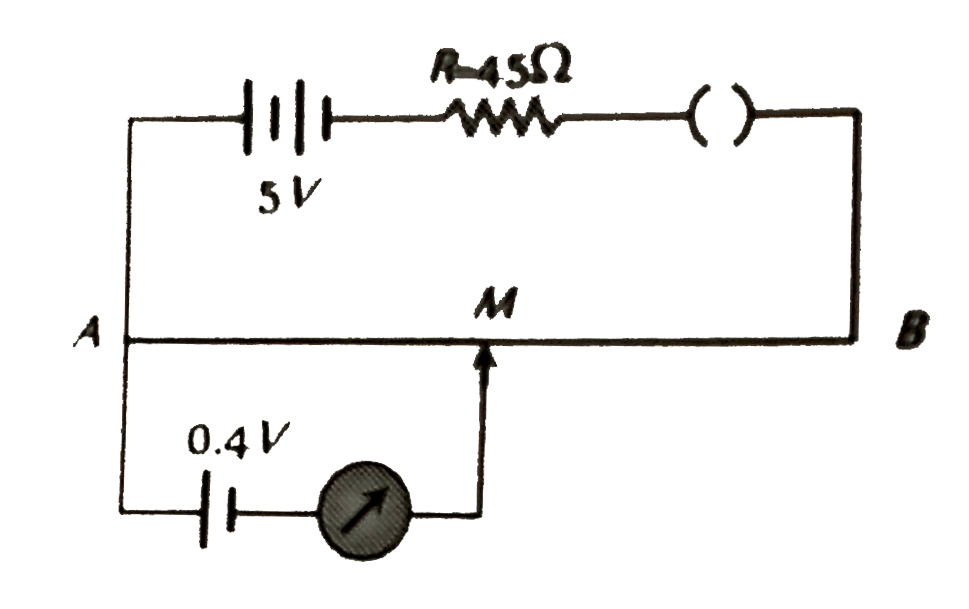In an experiment with a potentiometer, VB=10V. R is adjusted to be 50Ω (see figure) . A student wanting to measure voltage E1 of a battery ( approx. 8V) finds no null point.He then diminishes R to 10Ω and is able to locate the null point on the last (4th) segment of the potentiometer.Find the resistance of the potentiometer wire and potential drop per unit length across the wire in the second case.

Let R' be the resistance of the potentiometer wire.
Effective resistance of potentiometer and variable resistor (R=50Ω) is given by =50Ω+R' Effective voltage applied across potentiometer=10V.
the current through the main circuit,
I=V50Ω+R=1050Ω+R
Potential difference across wire of potentiometer
IR'=10R'50Ω+R
Since with 50Ω resistor, null point is not obtained it's possible only when
10×R'50+R=1050Ω+R
Potential difference across wire of potentiometer,
IR'=10R'50Ω+R
Since with 50Ω resistor, null point is not obtained it's possible only when
10×R'50+R<8
⇒10R<400+8R'
2R'<400 or R'<200Ω
Similarly with 10Ω resistor, null point is obtained its possible only when
10×R'10+R'>8
⇒2R'>80
R'>40
10×34R'10+R'<8
⇒7.5R'<80+8R'
R'>160
⇒160<R'<200
Any R' between 160Ωand200Ω will achieve.
Since, the null point on the last (4th) segment of the potentiometer, therefore potential drop this imply that potential gradient
k×400cm>8V
or k×4m>8V
Similarly, potential drop across 300 cm wire <8V
k×100cm<8V
or k×103m<8V
k<223V/m
Thus, 223V/m>k>2V/m
Topper's Solved these Questions
- CURRENT ELECTRICITYBook:NCERT EXEMPLAR ENGLISHChapter:CURRENT ELECTRICITYExercise:MCQs (More than one options)
Explore 5 Videos
- COMMUNICATION SYSTEMBook:NCERT EXEMPLAR ENGLISHChapter:COMMUNICATION SYSTEMExercise:LONG ANSWER TYPE QUESTIONS
Explore 5 Videos
- DUAL NATURE OF RADIATION AND MATTERBook:NCERT EXEMPLAR ENGLISHChapter:DUAL NATURE OF RADIATION AND MATTERExercise:LONG ANSWER TYPE QUESTION
Explore 5 Videos
Similar Questions
Knowledge Check
The potentiometer wire of length 200cm has a resistance of 20Ω. It is connected in series with a resistance 10Ω and an accumulator of emf 6V having negligible internal resistance. A source of 2.4V is balanced against length 1 of the potentiometer wire. Find the length l of the potentiometer wire. Find the length l
 A100cmB120cmC110cmD140cm
A100cmB120cmC110cmD140cm
A 2 V battery, a 990Ω resistor and a potentiometer of 2 m length, all are connected in series of the resistance of potentiometer wire is 10Ω, then the potential gradient of the potentiometer wire is
View SolutionA 2 V battery, a 990Ω resistor and a potentiometer of 2 m length, all are connected in series of the resistance of potentiometer wire is 10Ω, then the potential gradient of the potentiometer wire is
View SolutionIf the length of potentiometer wire is increased, then the accuracy in the determination of null point
View SolutionIn an experiment with a potentiometer, the null point is
obtained at a distance of 60cm along the wire from the
common terminal with a leclanche cell. When a shunt
resistance of 1Ω is connected across the cell, the null
point shifts to a distance of 30cm from the common
terminal. what is the internal resistance of the cell?
View SolutionPotentiometer wire of length 1m is connected in series with 490Ω resistance and 2V battery. If 0.2mVcm is the potential gradient, then resistance of the potentiameter wire is approximately
View SolutionPotentiometer wire of length 1m is connected in series with 490Ω resistance and 2V battery. If 0.2mVcm is the potential gradient, then resistance of the potentiameter wire is approximately
View SolutionIn every experiment with potentiometer in the null point state, the potential difference between the ends of the galvanometer is
View Solution

